Introduction to Fingerprints
Fingerprints have been the gold model for individual identification in the forensic area for more than one hundred years. It is one of the major fields of Forensic Science.
Dactyloscopy is the study of the structure which had found on our fingertips for the means of identification.
These are the individual characteristic that had used to identify the person.
That means, no two individuals even identical twins can’t have similar fingerprints. Moreover, these fingermarks remain unchanged during the lifetime of the individual.
These ridges are present on the palmer and plantar surface that were formed at the developing stages of the fetus.
However, in some cases, these ridges can change such as a permanent scar or skin disorders like leprosy.
Fingerprints are commonly used tools to understand the individuality of a person to reveal his or her identity. It is hard to commit a crime without the aid and assistance of the hands.
Development And History of Fingerprints
The history of the fingerprint was quite interesting. The development of fingerprints had found in ancient Babylonian, Chinese, Persian, and Roman civilizations. These fingerprints are considered the oldest friction ridge skin impressions found to date.
In 1892, Sir Francis Galton established that no two fingerprints were alike. Sir Francis Galton continued his work and had written their observations on fingerprint examination and identification.
Later, Khan Bahadur Azizul Haque and Rai Bahadur Hem Chandra Bose, two Bengal Police officers, also co-joined the work on the development of fingerprint and its classification system. It came to be known as Henry’s ten-digit classification system.
Types of Fingerprints
1. Arches
About 5% of all ridge patterns are arches patterns.
In general, ridges enter from one side of the print to the other while forming a structure like an arch. There are no re-curving ridges found in the arch pattern.
There are two types of arches pattern;
A. Plain Arches
Plain arch is a simple pattern. It had formed when ridges enter from the left side and flowed towards the right side of the pattern with a small rise in the center resembling a hill.
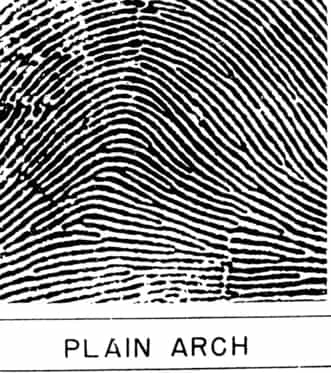
B. Tented Arches
In this pattern, mostly ridges enter from the left side and flow towards the right side, forming a sharp angle.
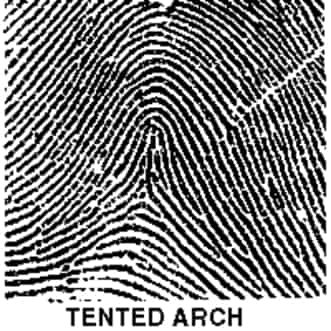
2. Loop
Some, about 60 to 65% of all patterns are of loop type.
A loop is formed by one or more ridges entering from one side and bending around a core to form a loop pattern and then flowing back on the same side of the area from which they entered.
A loop has a delta and a core.
A. Radial Loop
The loop had formed by ridges, which enter from one side and flow back after re-curving around the core, to the same side with the opening in the loop pointing towards the radial bone.
B. Ulnar Loop
The loop had formed by ridges, which enter from one side and flow back after re-curving around the core, to the same side with the opening in the loop pointing towards the ulnar bone.
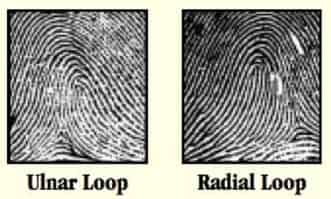
3. Whorl
30 to 35% of all the patterns are of whorl type.
It has two deltas and at least one ridge that makes a complete circuit, which may be spiral, oval, circular, or any variant of a circle.
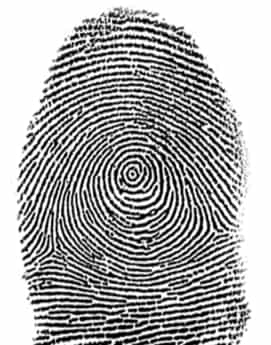
4. Composite
It is the combination of the two patterns. It constitutes 1% to 2% of the total collection.
A. Central Pocket Loop
This pattern combines the features of both the loop and the whorl.
In this pattern, the majority of the ridges have the appearance of a loop, but in which, one or more ridges within the pattern recurving about the core and make a pocket.
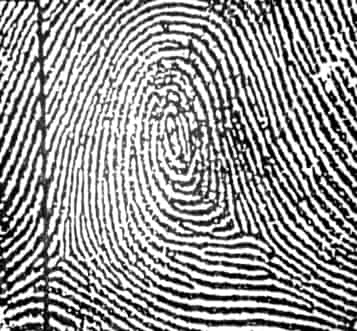
B. Lateral Pocket Loop
It is the double loop pattern. Both loop formations flow in the same direction with core lines without being divided by either in the delta.

C. Twin Loop
It is also a double loop. It had formed by two loops overlapping each other and having the termination in the ridges representing the core of each loop separated by one of the deltas.
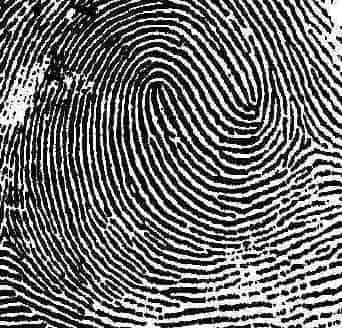
D. Accidental
This pattern is irregular and formed by the mixture of any two different patterns except a combination in which one of the patterns is an arch. It has at least two deltas.
When a pattern had formed by a loop over a plain arch it had interpreted not as an accidental but as a nutant loop or a nascent loop.

Conclusion
The science of fingerprinting is a century-old discovery. One of the main importance of fingerprints is to develop the unique identity of each person with minimum time and effort. This technique provides the fastest way to investigate the crime and catch the culprit.
The fingerprint evidence has been referred to as a reliable piece of evidence. The courts must form an opinion only after discussion or after concerning an expert. It plays an important role in identifying convicts. The fingerprint of convicts had been taken on the slips for the records. These all records are present in court during the trial.
The fingerprint of unidentified dead bodies had also been taken to help identify the deceased at a later date. The fingerprint of suspects had been taken for identification with the chance fingerprint which had been left at the crime scene. Thumbprints are present on the documents so, these prints had also collected for identification.
Read More: 47 Branches Of Forensic Science: Disciplines And Division With Evidence And Case Types

A post-graduate student of MSc. Forensic Science from Amity University. She also completed certification courses such as the French language, Russian language, Communication skills, behavioral science, and entrepreneurship courses. Moreover, she too has a good understanding of computers.

FR Author Group at ForensicReader is a team of Forensic experts and scholars having B.Sc, M.Sc, or Doctorate( Ph.D.) degrees in Forensic Science. We published on topics on fingerprints, questioned documents, forensic medicine, toxicology, physical evidence, and related case studies. Know More.
